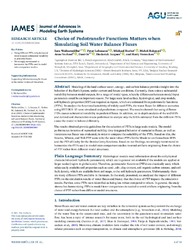Choice of Pedotransfer Functions Matters when Simulating Soil Water Balance Fluxes
Weihermüller, Lutz; Lehmann, Peter; Herbst, Michael; Rahmati, Mehdi; Verhoef, Anne; Or, Dani; Jacques, Diederick; Vereecken, Harry, 2021: Choice of Pedotransfer Functions Matters when Simulating Soil Water Balance Fluxes. In: Journal of Advances in Modeling Earth Systems, Band 13, 3, DOI: 10.23689/fidgeo-4305.
 |
Dokument öffnen: |
Modeling of the land surface water‐, energy‐, and carbon balance provides insight into the behavior of the Earth System, under current and future conditions. Currently, there exists a substantial variability between model outputs, for a range of model types, whereby differences between model input parameters could be an important reason. For large‐scale land surface, hydrological, and crop models, soil hydraulic properties (SHP) are required as inputs, which are estimated from pedotransfer functions (PTFs). To analyze the functional sensitivity of widely used PTFs, the water fluxes for different scenarios using HYDRUS‐1D were simulated and predictions compared. The results showed that using different PTFs causes substantial variability in predicted fluxes. In addition, an in‐depth analysis of the soil SHPs and derived soil characteristics was performed to analyze why the SHPs estimated from the different PTFs cause the model to behave differently.
The results obtained provide guidelines for the selection of PTFs in large scale models. The model performance in terms of numerical stability, time‐integrated behavior of cumulative fluxes, as well as instantaneous fluxes was evaluated, in order to compare the suitability of the PTFs. Based on this, the Rosetta, Wösten, and Tóth PTF seem to be the most robust PTFs for the Mualem van Genuchten SHPs and the PTF of Cosby for the Brooks Corey functions. Based on our findings, we strongly recommend to harmonize the PTFs used in model inter‐comparison studies to avoid artifacts originating from the choice of PTF rather from different model structures. Plain Language Summary:
Hydrological models need information about the soil physical characteristics (soil hydraulic parameters), which are in general not available if the models are applied at larger scales (region to global scale). Therefore, pedotransfer functions (PTFs) are classically used, which relate easily available soil properties such as sand‐, silt‐, clay‐content, soil organic carbon content, and soil bulk density, which are available from soil maps, to the soil hydraulic parameters. Unfortunately, there are many different PTFs available in literature. In the study presented, we analyzed the impact of different PTFs on the simulation results of water fluxes and found, that the choice of PTF impacts the simulation results. Further, some PTFs were identified as being less robust compared to others. In general, the study shows that harmonizing PTFs in model‐inter‐comparisons is needed to avoid artifacts originating from the choice of PTF rather from different model structures. Key Points:
Using different PTFs in hydrological models causes substantial variability in predicted fluxes.
We strongly recommend to harmonize the PTFs used in model inter‐comparison studies.
Statistik:
ZugriffsstatistikSammlung:
- Geologie [933]
Schlagworte:
crop modelshydrological models
land surface models
LSM
model ensemble mean
model inter‐comparison
pedotransfer functions
This is an open access article under the terms of the Creative Commons Attribution License, which permits use, distribution and reproduction in any medium, provided the original work is properly cited.

